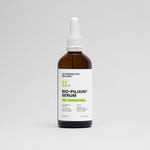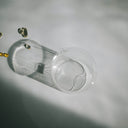Hair implants for women are a game-changer for those seeking a quick, non-surgical solution to thinning hair or bald patches.
While hair loss can feel like a personal battle, the right procedure can restore not just your hair but your confidence.
This article unpacks everything you need to know about hair implants, from how they work to who qualifies.
Table of content
What are hair implants for women?
Hair implants for women are a non-surgical solution to restore hair density using synthetic or biofiber strands. Unlike hair transplants, which rely on your natural follicles, implants offer an immediate improvement in appearance without waiting for regrowth.
These implants mimic natural hair, providing a fuller look for women experiencing hair loss. The procedure is ideal for those with specific hair-loss patterns or those who may not be candidates for traditional transplants.
While the results are not permanent, they can offer a significant confidence boost and a low-maintenance option for addressing hair loss.
The process is relatively straightforward, involving the insertion of synthetic fibers into the scalp using a minimally invasive technique. The fibers come in various shades and textures, allowing for a tailored look that matches your existing hair.
Types of hair implants for women
Hair implants come in different forms, catering to individual needs and preferences. The main types include:
- Synthetic hair implants: These are made from artificial fibers designed to closely resemble natural hair. They are durable, come in various styles and colors, and are ideal for quick results. However, they require regular maintenance and replacement over time.
- Biofiber implants: These are made from biocompatible materials that integrate well with the scalp. They look more natural and tend to cause fewer allergic reactions compared to traditional synthetic options. While they may cost more, their durability and realistic appearance make them a popular choice.
Who qualifies for hair implants?
Hair implants are not suitable for everyone but can work wonders for certain individuals. Ideal candidates include:
- Women with thinning hair or bald patches who want immediate results.
- Those who are not eligible for traditional hair transplants due to insufficient donor hair.
- Women looking for a minimally invasive hair restoration option.
- Individuals seeking temporary improvements rather than permanent solutions.
As your leading source for hair health information over the past 4 years, we never compromise on accuracy. When it comes to your health, you deserve information you can truly rely on - and earning your trust is our top priority.
Here's how Scandinavian Biolabs ensures every piece of content meets the highest standards of accuracy and integrity:
- Credentialed Experts: Our reviewers are actively practicing doctors and medical researchers
- Stringent Reviews: Content undergoes rigorous editing by subject specialists and review by a practicing doctor.
- Evidence-Based: We rely on well-established research from trusted scientific sources like peer-reviewed journals and health authorities.
- Full Transparency: Our editorial standards, writer credentials, reviewer credentials, correction process, and funding are all publicly documented.
- Independent Voice: While we do promote products, we operate in a vacuum to business operations. Our main goal is just an unwavering commitment to providing medically-sound guidance.
You can count on Scandinavian Biolabs to consistently deliver the trustworthy health information you deserve. Read our Editorial Standards.
How do hair implants work?
The procedure for hair implants is relatively simple and straightforward, involving the following steps:
-
Consultation and assessment: A professional evaluates your scalp condition and determines the best type of implant for your needs.
-
Scalp preparation: The area is cleaned and sometimes numbed with a local anesthetic to minimize discomfort.
-
Insertion of hair implants: Using a fine needle, synthetic or biofiber strands are implanted one by one into the scalp. The process is meticulous to ensure even spacing and a natural appearance.
-
Post-procedure care: The scalp is cleaned, and aftercare instructions are provided to maintain hygiene and ensure optimal results.
The entire procedure is typically completed within a single session, though follow-ups may be needed for adjustments.
How long the procedure takes?

Hair implant procedures usually take about 2–5 hours, depending on the extent of hair loss and the number of implants required. This timeframe makes it a convenient option for women seeking immediate results.
The actual duration can vary based on individual needs. For instance, if a large area of the scalp is being treated, the procedure might extend closer to the 5-hour mark. Smaller touch-ups or partial coverage usually require less time.
While the procedure itself is efficient, it’s important to consider some downtime for minor scalp tenderness or redness afterward.
Most women can return to their regular routines within a day or two, making it a relatively hassle-free option.
What are the benefits of hair implants for women?
Hair implants for women offer a quick and effective way to improve hair density and appearance. Here’s a closer look at the main benefits:
Immediate results
Unlike traditional hair transplants, which take months to show growth, hair implants provide instant volume and coverage. Women struggling with thinning hair can walk out of the clinic with fuller-looking hair the same day.
This makes implants a great choice for those seeking fast improvements without waiting for natural regrowth.
Minimally invasive procedure
Hair implants don’t require surgery, making the process much less intimidating. There’s no need for stitches, scalpels, or long recovery periods.
Most women experience minimal discomfort and can return to their normal activities in just a day or two.
Customizable appearance
Implants come in a wide range of colors, lengths, and textures, allowing for a tailored look that matches natural hair.
Whether you want to fill in thinning areas or create a bold new style, implants can be designed to suit your preferences.
Suitable for those without donor hair
Women with severe thinning or scarring may not have enough healthy donor hair for a transplant.
Hair implants solve this issue by using synthetic or biofiber strands, making them an accessible option for a wider range of candidates.
Low maintenance
Once in place, hair implants require little upkeep. With proper care and occasional replacements, they can maintain their look and feel for years.
Hair implants vs. hair transplants – Key differences
Here are the key differences between hair implants and hair transplants:
- Procedure – Hair implants involve inserting synthetic fibers, while hair transplants use your natural hair follicles.
- Results – Implants offer instant volume, whereas transplants take several months for visible growth.
- Durability – Transplants provide permanent results, while implants may need periodic replacements.
- Maintenance – Implants require occasional touch-ups, while transplants grow naturally and need less upkeep.
- Suitability – Implants are ideal for those without donor hair, but transplants require healthy donor areas for grafts.
Are there any risks for women with hair implants?

Hair implants are generally safe, but like any procedure, they come with a few risks. The most common issues involve scalp sensitivity, mild irritation, or temporary redness immediately after the procedure.
While most side effects fade quickly, some women may experience allergic reactions to the synthetic fibers or mild infections if proper aftercare isn’t followed. It’s important to discuss any concerns with a professional before deciding if implants are right for you.
Potential risks include:
- Allergic reactions to synthetic fibers.
- Scalp irritation or inflammation.
- Infection if hygiene instructions are not followed.
- Gradual shedding or loosening of implants over time.
- Difficulty matching the color or texture with natural hair.
How much does a female hair implant cost?
The cost of female hair implants typically ranges from £2,000 to £6,000, depending on the area being treated and the type of implants used. Prices may vary based on the clinic’s expertise, location, and the number of fibers required.
Larger areas needing more implants tend to increase the cost, while smaller touch-ups or partial coverage often fall on the lower end of the price scale.
Synthetic implants are usually less expensive than biofiber options, but biofibers may offer a more natural look and longer-lasting results.
Financing plans are often available for those who need flexible payment options. Be sure to ask during consultations about package deals or payment plans that can help make the procedure more affordable.
How long do hair implants last?
Hair implants can last several years with proper care, but they are not permanent like hair transplants. Regular maintenance and replacements may be needed to keep them looking their best.
Synthetic fibers, in particular, are prone to wear and tear over time, especially if exposed to frequent styling or harsh chemicals. Biofiber implants may last longer due to their stronger material and better integration with the scalp.
Routine check-ups with your specialist can help monitor the condition of the implants and replace any strands that show signs of damage or shedding.
With consistent care, many women find their implants remain attractive and functional for 5–10 years.
Who should avoid hair implants?
Women with sensitive scalps, allergies to synthetic materials, or active scalp conditions should avoid hair implants. This procedure also isn’t recommended for those looking for permanent results.
People who may not be ideal candidates include:
- Women with ongoing scalp infections or skin conditions like eczema.
- Those prone to allergic reactions to synthetic fibers.
- Individuals with unrealistic expectations about long-term results.
- Women experiencing temporary hair loss, such as postpartum shedding or telogen effluvium.
- Those unwilling to commit to occasional maintenance or replacements.
A better alternative to hair implants for women

If you’re looking for a non-invasive option to tackle hair loss, Bio-Pilixin® Activation Serum might be a solution worth exploring.
Developed with plant-based ingredients and backed by clinical research, this serum is designed to help reduce shedding and encourage hair growth—without the need for surgery or synthetic fibers.
Created by experts, Bio-Pilixin® is drug-free and gentle enough for daily use. Its formula includes plant growth factors developed through stem cell technology, which work to nourish hair follicles and support healthier, thicker hair over time.
Key features include:
- Clinically tested – Research has shown it may help reduce hair loss and improve hair density.
- Supports hair growth – Designed to activate and sustain follicle activity.
- Safe and drug-free – Suitable for regular use without harsh chemicals.
The science behind Bio-Pilixin® is promising. In a clinical study involving 30 participants aged 18–65 with varying types of hair loss, results were seen in as little as 45 days.
Around 77% reported reduced shedding within 45 days, and by 150 days, 93% experienced noticeable reductions in hair loss.
Additionally, 73% showed measurable improvements in hair density after 150 days.
While results naturally vary from person to person, many users have noticed early improvements, such as less hair left behind in the shower or on hairbrushes.
For others, changes in density and thickness became more visible around the 150-day mark.
Bio-Pilixin® also comes with a 150-day money-back guarantee, giving you the chance to try it with confidence.
Hair growth takes time, so patience is key—but with consistent use, this serum may offer a gentler, science-backed approach to hair restoration.
Conclusion
Hair implants for women can be a practical option for those looking for quick results, especially if surgery isn’t an option.
They offer instant volume, require minimal downtime, and can be customized to match your natural hair. However, implants do need maintenance and aren’t a permanent fix.
For women looking for a non-surgical, drug-free approach, products like Bio-Pilixin® Activation Serum may help support natural hair growth and reduce shedding.
With plant-based ingredients and clinical backing, it offers a gentler alternative to implants.
Ready to take the next step toward healthier hair?
Try Bio-Pilixin® Activation Serum today and explore a simpler way to care for your hair.
References:





